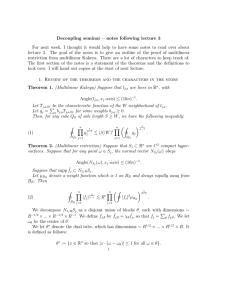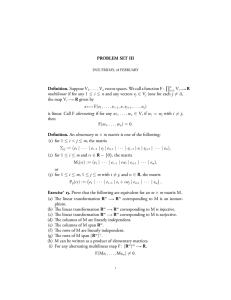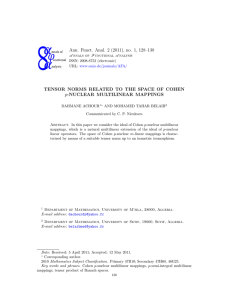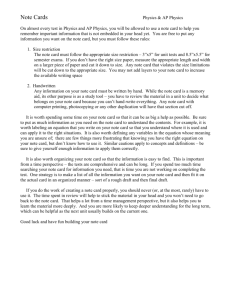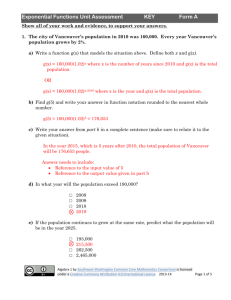Decoupling seminar – problem set after lecture 4
advertisement
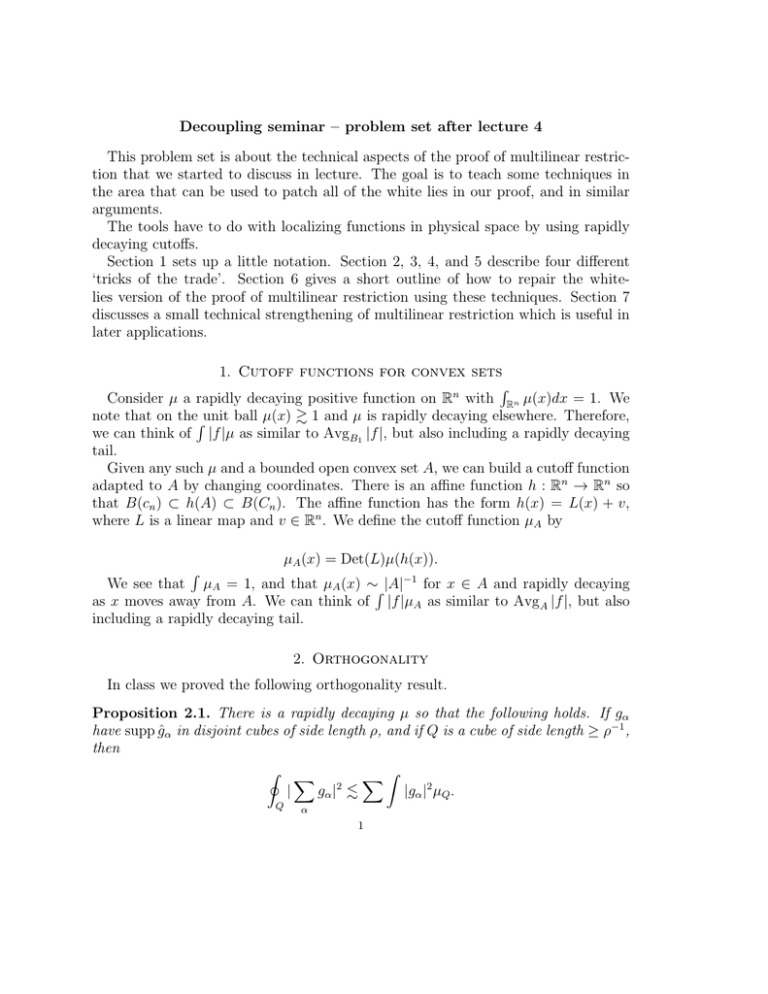
Decoupling seminar – problem set after lecture 4
This problem set is about the technical aspects of the proof of multilinear restriction that we started to discuss in lecture. The goal is to teach some techniques in
the area that can be used to patch all of the white lies in our proof, and in similar
arguments.
The tools have to do with localizing functions in physical space by using rapidly
decaying cutoffs.
Section 1 sets up a little notation. Section 2, 3, 4, and 5 describe four different
‘tricks of the trade’. Section 6 gives a short outline of how to repair the whitelies version of the proof of multilinear restriction using these techniques. Section 7
discusses a small technical strengthening of multilinear restriction which is useful in
later applications.
1. Cutoff functions for convex sets
R
Consider µ a rapidly decaying positive function on Rn with Rn µ(x)dx = 1. We
note that on theRunit ball µ(x) & 1 and µ is rapidly decaying elsewhere. Therefore,
we can think of |f |µ as similar to AvgB1 |f |, but also including a rapidly decaying
tail.
Given any such µ and a bounded open convex set A, we can build a cutoff function
adapted to A by changing coordinates. There is an affine function h : Rn → Rn so
that B(cn ) ⊂ h(A) ⊂ B(Cn ). The affine function has the form h(x) = L(x) + v,
where L is a linear map and v ∈ Rn . We define the cutoff function µA by
µA (x) = Det(L)µ(h(x)).
We see that µA = 1, and that µA (x) ∼R |A|−1 for x ∈ A and rapidly decaying
as x moves away from A. We can think of |f |µA as similar to AvgA |f |, but also
including a rapidly decaying tail.
R
2. Orthogonality
In class we proved the following orthogonality result.
Proposition 2.1. There is a rapidly decaying µ so that the following holds. If gα
have supp ĝα in disjoint cubes of side length ρ, and if Q is a cube of side length ≥ ρ−1 ,
then
I X
XZ
2
|
gα | .
|gα |2 µQ .
Q
α
1
2
Exercise. Using this result as a black box, prove that for any rapidly decaying µ,
there is a rapidly decaying µ+ so that the following holds:
Z X
XZ
2
|
gα | µQ .
|gα |2 µ+
Q.
α
n
Let K ⊂ R be a (bounded open) convex set with center of mass ωK . (We think
of K as living in Fourier space.) Define the dual convex body K ∗ by
K ∗ := {x ∈ Rn so that |x · (ωK − ω)| ≤ 1 for all ω ∈ K}.
Exercise 2. Modifying the proof of Proposition 2.1, prove the following:
Proposition 2.2. There is a rapidly decaying µ so that the following holds. If gα
have supp ĝα in disjoint translates of a convex set K, and if A is a translate of K ∗ ,
then
I X
XZ
2
|gα |2 µA .
gα | .
|
A
α
3. Locally constant properties
In class, we prove the following ‘morally locally constant’ estimate.
Proposition 3.1. There is a rapidly decaying µ so that the following holds. If
supp ĝ ⊂ K (a bounded open convex set), then |g| . |g| ∗ µK ∗ .
Moreover, for any x ∈ Rn ,
max |g| . min∗ |g| ∗ µK ∗ .
x+K ∗
x+K
Exercise 1. As a corollary of this Proposition, prove a weak multilinear restriction
estimate with a polynomial error factor: If fj obey the hypotheses of multilinear
restriction, then
I
QR
Y
|fj |
2
n−1
.R
Cn
Y Z
2
|fj | µQR
1
n−1
.
j
j
Exercise 2. For any rapidly decaying µ, there is a rapidly decaying µ+ so that the
following hold. If supp ĝ ⊂ K (a bounded open convex set), then for any x ∈ Rn ,
max |g| ∗ µK ∗ . min∗ |g| ∗ µ+
K∗ .
x+K ∗
x+K
3
4. Two kinds of fudges
H
In the white lies version of the proof, we often have a quantity like Q 1/2 |fj,θ |2
R
which will need to be replaced by something involving a rapidly decaying cutoff
µQR1/2 . In the discussion so far, we’ve seen two different ways this cutoff function
could appear:
Z
I
2
|fj,θ | µQR1/2 or
(|fj,θ | ∗ µQR1/2 )2 .
QR1/2
If we’re not careful these different kinds of fudges can pile on top of each other
in a confusing way. A useful technical point is that these two kinds of fudges are
basically equivalent. Prove the following two lemmas that makes this precise.
Lemma 1. For any rapidly decaying µ, there is a rapidly decaying µ+ so that the
following holds. If supp ĝ lies in a bounded open convex set K, and if A is a translate
of K ∗ , then for any p ≥ 1,
Z
I
p
p
|g| µA . (|g| ∗ µ+
A) .
A
Lemma 2. For any rapidly decaying µ, there is a rapidly decaying µ+ so that the
following holds. If supp ĝ lies in a bounded open convex set K, and if A is a translate
of K ∗ , then for any p ≥ 1,
Z
I
p
(|g| ∗ µA ) . |g|p µ+
A.
A
5. A last localization trick
Here is one other issue that will come up when trying to remove the white lies
from the proof of multilinear restriction. In the white lie version of orthogonality,
we said that if gα have supp ĝα in disjoint cubes of side length ρ, and if Q is a cube
of side length ≥ ρ−1 , then
I X
XI
2
|
gα | ∼
|gα |2 .
(white lie 1)
Q
α
Q
We proved a true estimate with a rapidly decaying cutoff, but it only goes in one
direction:
I X
XZ
2
|
gα | .
|gα |2 µQ .
Q
Can we go the other way?
α
4
Exercise: Suppose that gα have supp ĝα in disjoint cubes of side length ρ, and Q
is a cube of side length ≥ ρ−1 . Show that it is not always true that
Z
XI
2
|gα | . |g|2 µQ .
Q
To avoid using orthogonality “in the wrong direction”, we need one last localization
trick.
Exercise. Suppose we know that for any fj with supp fˆj ⊂ NC/R Sj as in the
statement of multilinear restriction, that we have the following inequality:
I
Y
QR
|fj |
2
n−1
≤M
Y
R
−n
Z
1
n−1
|fj |
.
(global)
Rn
j
j
2
Using this as a black box, show that there is a rapidly decaying µ so that
I
Y
QR
|fj |
2
n−1
≤ Cn M
Y Z
1
n−1
2
|fj | µQR
.
(localized)
j
j
Hint: Multiply fj by a cutoff function ψQR with ψQR ∼ 1 on QR and rapidly
decaying, and with supp ψ̂QR ⊂ B(1/R).
Because of this exercise, the localized and global versions of the multilinear restriction inequality are essentially equivalent.
6. A rigorous proof of multilinear restriction
Suppose that for some rapidly decaying µ, we know that
I
Y
QR1/2
|fj |
2
n−1
≤ M (R
1/2
Y Z
)
j
1
n−1
2
|fj | µQR1/2
.
j
Following the white lie proof of multilinear restriction, and using the tricks in the
sections above, prove that
I
Y
QR
|fj |
2
n−1
. R M (R
1/2
)
Y
j
R
−n
Z
2
1
n−1
|fj |
.
Rn
j
Finally, using the last localization trick, conclude that there is some rapidly decaying µ+ so that
I
QR
Y
j
|fj |
2
n−1
. R M (R
1/2
)
Y Z
j
|fj |2 µ+
QR
1
n−1
.
5
(With a little more thought, one can also arrange that µ+ = µ, but it’s not
important.)
Iterating this argument, prove multilinear restriction. (It may be helpful to use
Exercise 3.1 from Section 3 above as a base case for your iteration.)
7. A slightly stronger version of multilinear restriction
Show that the same arguments actually give the following technically slightly
stronger result, which is convenient for the applications in decoupling:
Theorem 1. There is a rapidly decaying µ so that the following holds. Let fj be as
in multilinear restriction. Then
1
2
n−1
n−1
Y Z
Y
2
.R
|fj | µQR
.
AvgQ1 ⊂QR
max |fj |
j
Q1
j
Morally, the functions |fj | are locally constant at scale 1, and so this should be
equivalent to multilinear restriction. With the technical tools here, we can prove it
with essentially the same argument that proved multilinear restriction.

